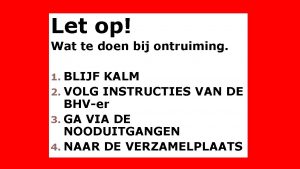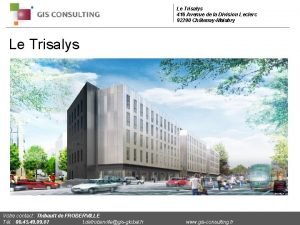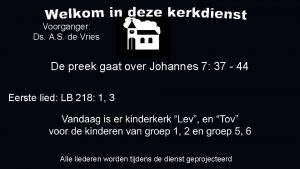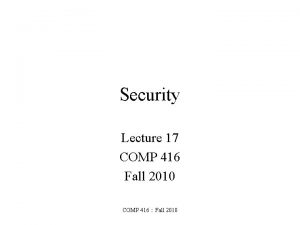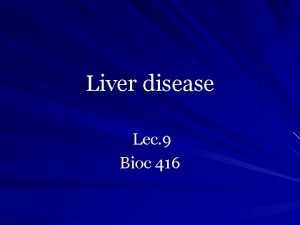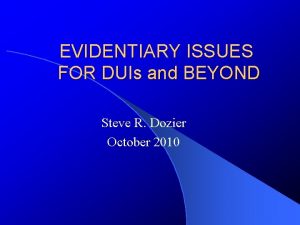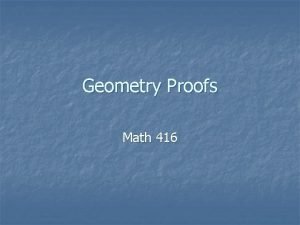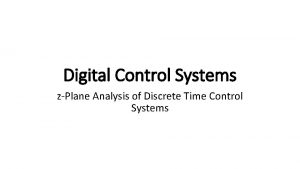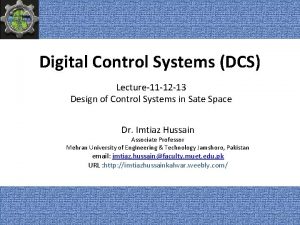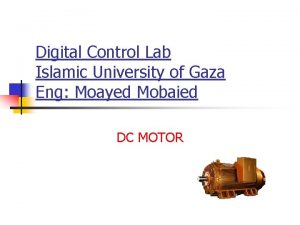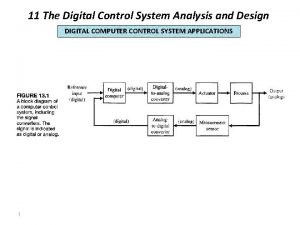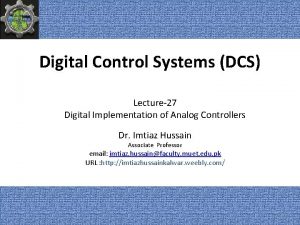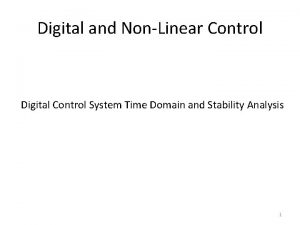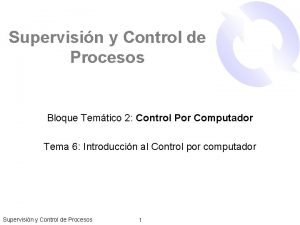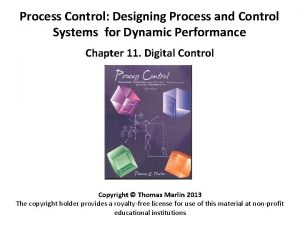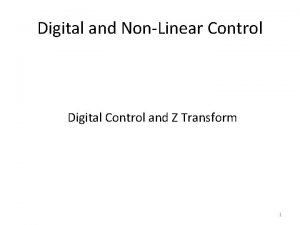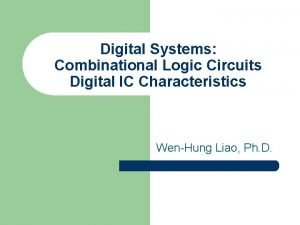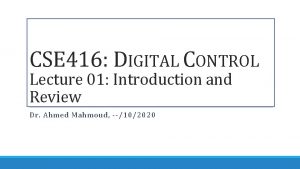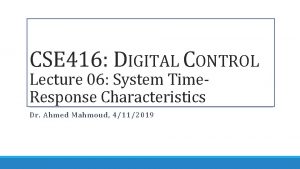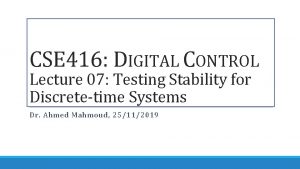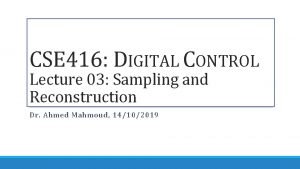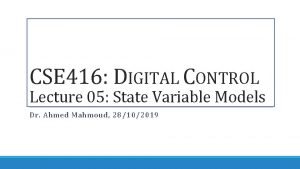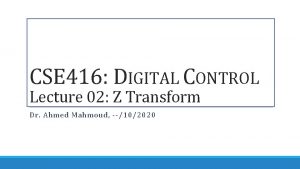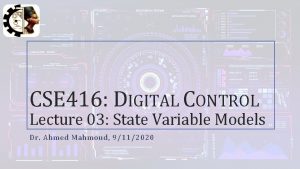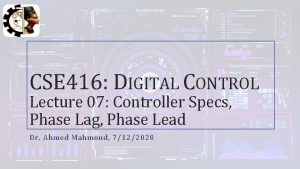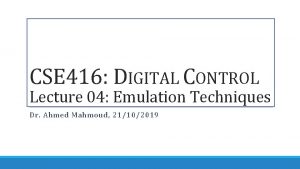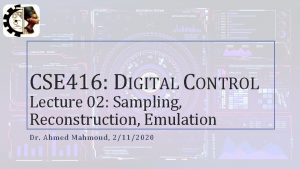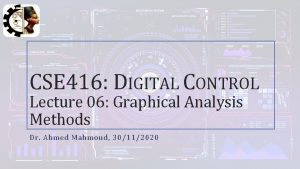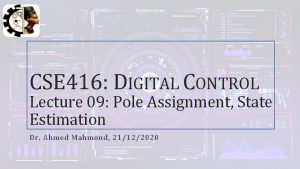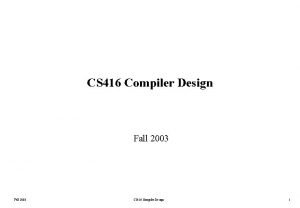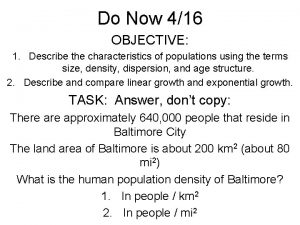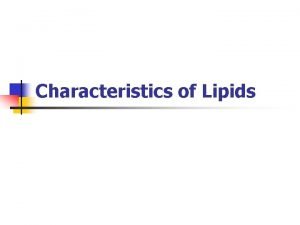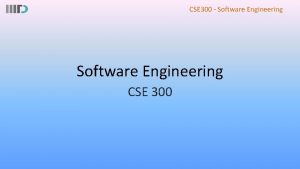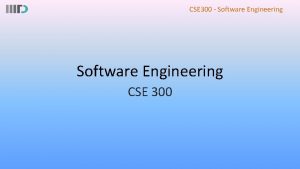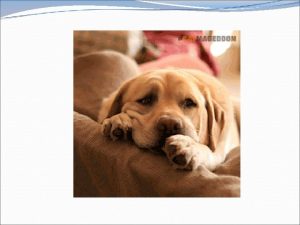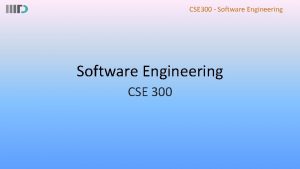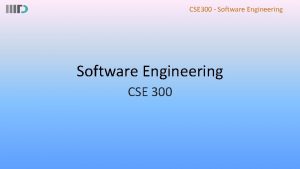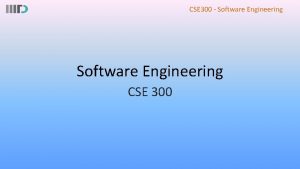CSE 416 DIGITAL CONTROL Lecture 04 TimeResponse Characteristics




































- Slides: 36

CSE 416: DIGITAL CONTROL Lecture 04: Time-Response Characteristics and Stability Dr. Ahmed Mahmoud, 16/11/2020

First-Order Model (1) • Find the unit step response for the continuous and discrete model of the following system: 16/11/2020 CSE 416: Digital Control, Lec 04 2

First-Order Model (2): Continuous … • The analog closed-loop transfer function: • The time-domain solution: 16/11/2020 CSE 416: Digital Control, Lec 04 3

First-Order Model (3): Discrete … 16/11/2020 CSE 416: Digital Control, Lec 04 4

First-Order Model (4): Discrete … • Since : • Then: • The inverse z-transform for output: 16/11/2020 CSE 416: Digital Control, Lec 04 5

First-Order Model (5) 16/11/2020 CSE 416: Digital Control, Lec 04 6

First-Order Model (6): Another Solution … • The response can also be calculated for the sampled-data series: • For the discrete part expression: • The continuous part is factored as: 16/11/2020 CSE 416: Digital Control, Lec 04 7

First-Order Model (7): Another Solution … 16/11/2020 CSE 416: Digital Control, Lec 04 8

First-Order Model (7): Final Value 16/11/2020 CSE 416: Digital Control, Lec 04 9

Natural Response 16/11/2020 CSE 416: Digital Control, Lec 04 10

Second-Order Model (1) • Find the unit step response for the continuous and discrete model of the following system: 16/11/2020 CSE 416: Digital Control, Lec 04 11

Second-Order Model (2): Continuous … • The analog closed-loop transfer function: • This a typical second order system with: 16/11/2020 CSE 416: Digital Control, Lec 04 12

Second-Order Model (3): Discrete … 16/11/2020 CSE 416: Digital Control, Lec 04 13

Second-Order Model (4): Discrete … • Since : • Then: • The final value is: 16/11/2020 CSE 416: Digital Control, Lec 04 14

Second-Order Model (6): Another Solution 16/11/2020 CSE 416: Digital Control, Lec 04 15

Second-Order Model (7) 16/11/2020 CSE 416: Digital Control, Lec 04 16

Characteristic Equation 16/11/2020 CSE 416: Digital Control, Lec 04 17

• Constant frequency loci: 16/11/2020 CSE 416: Digital Control, Lec 04 18

• Constant damping loci: 16/11/2020 CSE 416: Digital Control, Lec 04 19

• Mapping the primary strip: • The stable region of the s-plane is the left half-plane → the stable region of the zplane is the interior of the unit circle. 16/11/2020 CSE 416: Digital Control, Lec 04 20

Transient Response and Pole Locations 16/11/2020 CSE 416: Digital Control, Lec 04 21

System Type 16/11/2020 CSE 416: Digital Control, Lec 04 22

Steady State Error 16/11/2020 CSE 416: Digital Control, Lec 04 23

Characteristic Equation (1) • The feedback system has the following transfer function: • Using partial fractions, the system can be expressed as: 16/11/2020 CSE 416: Digital Control, Lec 04 24

Characteristic Equation (2) 16/11/2020 CSE 416: Digital Control, Lec 04 25

Stability for Discrete-time Systems • Many analysis and design techniques for continuous-time LTI systems, such as the Routh–Hurwitz criterion and Bode techniques, are based on the property that in the s-plane the stability boundary is the imaginary axis. • These techniques cannot be applied to LTI discrete-time systems in the z-plane since the stability boundary is the unit circle. • Either: 1. Transform the discrete-time system back to continuous system (Bilinear transform). 2. Use tools for discrete-time systems (Jury’s test). 16/11/2020 CSE 416: Digital Control, Lec 04 26

Bilinear Transform 16/11/2020 CSE 416: Digital Control, Lec 04 27

Review on Routh-Hurwitz Criterion (1) 1. For the characteristic equation: Form the Routh array as follows: 16/11/2020 CSE 416: Digital Control, Lec 04 28

Review on Routh-Hurwitz Criterion (2) 2. The remaining rows are calculated as follows: 3. Once the array has been formed, the Routh–Hurwitz criterion states that the number of roots of the characteristic equation with positive real parts is equal to the number of sign changes of the coefficients in the first column of the array. 16/11/2020 CSE 416: Digital Control, Lec 04 29

Example on Routh-Hurwitz with Bilinear … 16/11/2020 CSE 416: Digital Control, Lec 04 30

Example on Routh-Hurwitz with Bilinear … 16/11/2020 CSE 416: Digital Control, Lec 04 31

Example on Routh-Hurwitz with Bilinear … 16/11/2020 CSE 416: Digital Control, Lec 04 32

Jury’s Stability Test (1) 16/11/2020 CSE 416: Digital Control, Lec 04 33

Jury’s Stability Test (1) 16/11/2020 CSE 416: Digital Control, Lec 04 34

Example on Jury’s Stability Test • Investigate the stability for the following characteristic equation: • Test the first conditions: • Then, construct the Jury’s array as follows and test the remaining conditions: • The system is stable. 16/11/2020 CSE 416: Digital Control, Lec 04 35

Reading • Read Chapter 6. • Read Sections 7. 1 to 7. 5. 16/11/2020 CSE 416: Digital Control, Lec 04 36
 Nlb 416
Nlb 416 416 avenue de la division leclerc 92290 châtenay-malabry
416 avenue de la division leclerc 92290 châtenay-malabry Gezang 250
Gezang 250 Opwekking 416
Opwekking 416 La 416
La 416 Comp 416
Comp 416 416 lec
416 lec Tca 55-10-416
Tca 55-10-416 Math 416 equivalent
Math 416 equivalent Omega 5 gliadin
Omega 5 gliadin 01:640:244 lecture notes - lecture 15: plat, idah, farad
01:640:244 lecture notes - lecture 15: plat, idah, farad Warga digital adalah...
Warga digital adalah... Digital goods ecommerce
Digital goods ecommerce Digital data digital signals
Digital data digital signals Digital data transmission
Digital data transmission E-commerce: digital markets, digital goods
E-commerce: digital markets, digital goods Signal encoding techniques in data communication
Signal encoding techniques in data communication Healthtech ecosystem
Healthtech ecosystem E-commerce digital markets digital goods
E-commerce digital markets digital goods Pulse transfer function in digital control system
Pulse transfer function in digital control system Feedback matrix examples
Feedback matrix examples Digital control lab
Digital control lab System analysis
System analysis Introduction to digital control
Introduction to digital control Introduction to digital control system
Introduction to digital control system Digital control
Digital control Digital control
Digital control Control digital
Control digital Control digital
Control digital Z transform is a non-linear operation
Z transform is a non-linear operation Characteristics of digital ic
Characteristics of digital ic Characteristics of digital system
Characteristics of digital system Characteristics of digital image
Characteristics of digital image Translational research institute on pain in later life
Translational research institute on pain in later life Process control and product control
Process control and product control Reynolds transport theorem
Reynolds transport theorem Stock control e flow control
Stock control e flow control
